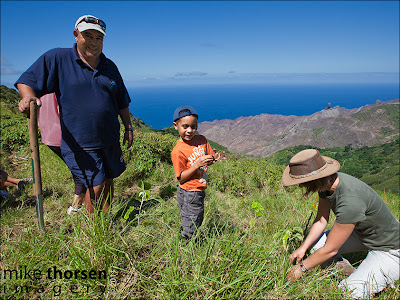 |
| Jo (right) with her co-worker Carolyn at the Longwood Fair |
 |
| Jo, 5 seconds later. Carolyn with the slightly puzzled expression all too common on people who spend time around Jo |
Life, conservation and photography on small, remote, islands pretty much in the middle of nowhere. You can contact mike on +64 (0)27 3500175 or imagery@xtra.co.nz
 |
| Jo (right) with her co-worker Carolyn at the Longwood Fair |
 |
| Jo, 5 seconds later. Carolyn with the slightly puzzled expression all too common on people who spend time around Jo |
 | ||
| The three Rs looking out over a cliff and wondering how they would get bugs off something that is vertical, windswept and about 100m high! |
 |
| Roger and Richard either sunbathing or looking at bugs on a beach. Since Roger's got a specimen jar in his hand I guess they're hunting inverts |
 |
| One of their techniques was the innovative use of a reversed leaf-blower to vacuum insects .... |
 |
| .... though Roger seemed blissfully unaware of the symbolism of this tool. |
 |
| They searched long and hard. Rosy sweep netting a very lonely wild mango |
 |
| Richard sought them here ... |
 |
| And Rosy sought them there too |
 |
| They caught things too! Roger with Isometrus maculatus - in other words, a scorpion |
 | |
| The endemic hoverfly Loveridgeana beattiei, a regular visitor to the flowers of endemic Saint Helena plants and probably one of the most important pollinators left |
 |
| And just to remind any entomologists out there - without plants you wouldn't have a job |
 |
| High Peak. The good bits are the dark areas towards the top. Most of the rest is grass and NZ's own flax |
 | |
| Volunteers planting endemics at High Peak during a recent open day. Checkout the contrast between the green highlands and the arid coastal zone |
 |
| Some Saints planting endemics |
 |
| Young Saints planting in a dense grove of the hybrid "rebony" Trochetiopsis x benjamini (T. ebenus cross with T. erythroxylon) |
 |
| Approaching Jamestown foreshore |
 |
| St Helena's fishing fleet moored in Jamestown Roads. It's a big sea and an even bigger sky before the next piece of land |
 |
| St Helena's fishing fleet and coastal cliffs |
 |
| Munden's Battery and the Bahrain prison perched on cliff near Jamestown |
 |
| Cliffs underneath Flagstaff in the north of St Helena |
 |
| Approaching the obviously-named Turks Cap in the east of St Helena. Strangely, when you walk along the coastal slopes it feels a lot steeper than pictured |
 |
| Shore Island |
 |
| Shore Island with Great Stone Top in background |
 |
| George Island with backdrop of Great Stone Top (highest coastal cliff in southern hemisphere) |
 |
| George Island, an important seabird nesting site |
 |
| Shore Island |
 |
| Waves battering a headland at Sandy Bay, in the east of St Helena |
 |
| The dike swarms in the cliffs of St Helena are renown to geologists worldwide. This is a view of a swarm (the dark lines) under Man O' War Roost in the south-east |
 |
| Speery Island (in the south). People climb this island to harvest guano for their gardens |
 |
| Another view of Speery Island |
 |
| Black noddies (Anous tenuirostris) busy replenishing the guano supply on Speery Island |